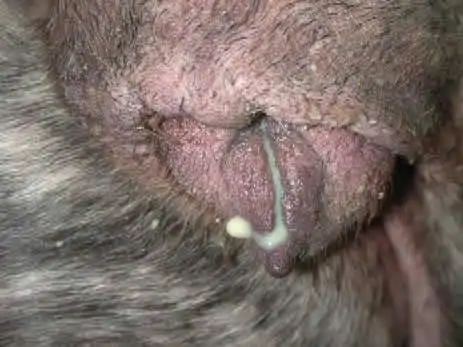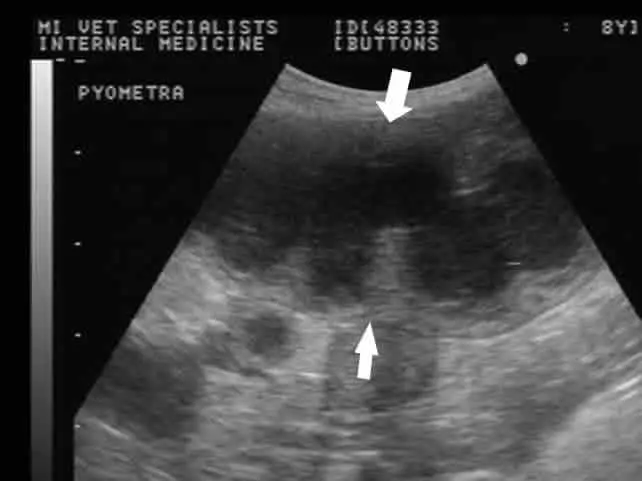Key Points
The word pyometra can be divided into two root words
- Pyo means pus
- Metra refers to the uterus
Pyometra starts after a dog goes through a heat cycle, usually within about 3 to 5 weeks
Spaying is the treatment of choice
Prognosis is usually favorable, providing that the patient is not profoundly ill
Anatomy
- The uterus is a Y-shaped organ that has two horns
- An ovary is located at the end of each horn of the uterus
Pathophysiology
- The word pyometra can be divided into two root words
- Pyo means pus
- Metra refers to the uterus
- Pyometra starts after a dog goes through a heat cycle, usually within about 3 to 5 weeks
- Stimulation of the uterus with abnormal levels of hormones (estrogen and progesterone) cause the lining of the uterus to become thickened and fluid accumulates inside the uterus
- Infection develops in the uterus
- As the infection progresses, the uterus fills with pus
- If the pet has closed pyometra the cervix is not open and pus cannot drain to the outside
- If open pyometra is present, the pus can drain through the cervix
- The infection is life-threatening; closed pyometra may cause a pet to become more ill than open pyometra
Clinical signs
- Pus may or may not drain from the vagina/vulva (see photo below)
- Increased thirst/increased urination
- Enlargement of the abdomen as the uterus fills with pus
- Lethargy
- Poor appetite
- Weight loss
- Enlargement of the abdomen
- Fever
- Dehydration
- Clinical signs are variable from pet to pet

Diagnostic tests
- Complete blood cell count usually shows an elevated white count
- Chemistry profile to evaluate function of internal organs
- Radiographs of the abdomen
- Ultrasound of the uterus (photo below shows a uterus filled with pus – black structure)
- Culture of the pus from the uterus
- Biopsy of the uterus if cancer is suspected

Treatment
- Fluid therapy via an IV to correct dehydration
- Antibiotics
- Transfusions of plasma, Hetastarch, whole blood
- Surgical removal of the uterus; photo below shows a very enlarged uterus that is filled with pus

Nonsurgical Treatment
- Fluid therapy
- Antibiotics
- Prostaglandins help the uterus to expel pus and alters the hormone levels of the ovaries
- This treatment should not be used if the pet is quite ill
- This treatment should not be used if your pet has closed pyometra
- This treatment may not work and surgery will need to be done
- If this treatment is successful, the next time the dog goes through heat, pyometra will usually recur unless the dog is bred and becomes pregnant
Aftercare
- Antibiotic therapy
- Restrict activity for 3 weeks
- Encourage eating and drinking
- Check incision for signs of infection
Potential complications
- Anesthetic death
- Bladder infection
- Peritonitis, which is infection of the abdomen
- Abdominal abscess formation
- Disseminated intravascular coagulation, which is a clotting disorder from the infection and causes death in many patients.
- Sepsis – poisoning of the body by toxins from bacteria
Prevention of pyometra
- Simply having your pet spayed at a young age will prevent pyometra and will decrease the risk of mammary cancer


